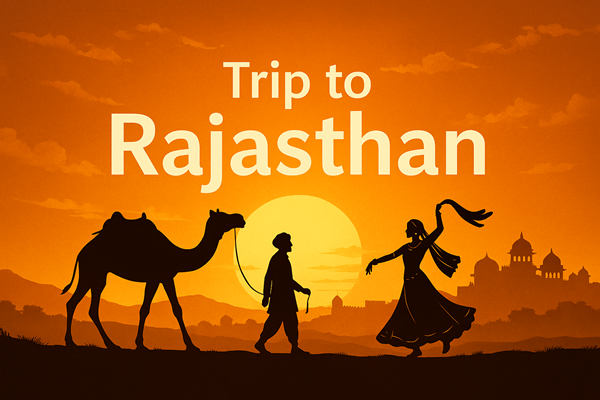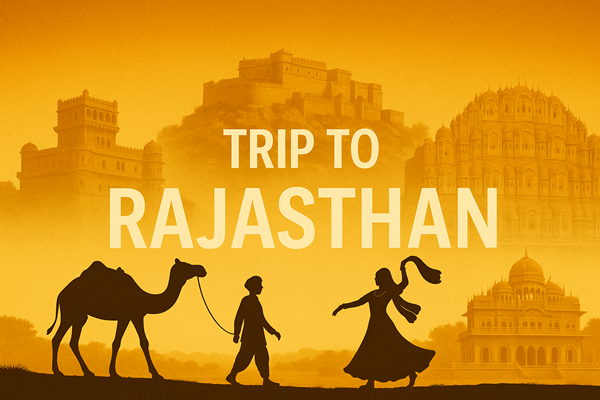Rajasthan, the land where every street echoes the tales of valor, romance, royalty, and vibrant traditions, is more than just a tourist destination—it’s an emotion. Whether you’re a solo traveler, a couple seeking heritage, a family on a cultural quest, or a backpacker chasing colors, Rajasthan offers something for everyone.
In this in-depth guide, explore the top places to visit in Rajasthan, their rich history, culture, food, best travel times, local festivals, do’s and don’ts, and everything else you need to know for a perfect Rajasthan itinerary.

Why plan a Trip to Rajasthan?
- Home to majestic forts, ancient temples, and royal palaces
- Gateway to Thar Desert adventures
- Authentic Rajasthani cuisine you can’t find anywhere else
- Colorful festivals like Pushkar Camel Fair and Desert Festival
- Rich cultural heritage and warm hospitality
1. Jaipur – The Pink City
A Glimpse into History
Founded in 1727 by Maharaja Sawai Jai Singh II, Jaipur was India’s first planned city. The city was painted pink in 1876 to welcome Prince Albert, which earned it the nickname “Pink City.”
Top Tourist Attractions
- Amber Fort – Known for its majestic structure and elephant rides
- Hawa Mahal – 953 windows built for royal women to watch street festivals
- City Palace – A royal complex with museums and courtyards
- Jantar Mantar – Ancient astronomical observatory
What to Eat
- Dal Baati Churma
- Ghevar (especially during Teej)
- Pyaz Kachori from Rawat Mishtan Bhandar
- Traditional Rajasthani Thali at Chokhi Dhani
Must-Attend Festivals
- Teej (July–August)
- Gangaur (March–April)
- Jaipur Literature Festival (January)
- Elephant Festival (Holi season)
Best Time to Visit
October to March for pleasant weather and festivals
Famous For
Handcrafted jewelry, block-printed textiles, camel leather goods, Precious Stones
Do’s & Don’ts
Do’s:
- Shop at Johari and Bapu Bazaar
- Use government-certified guides
Don’ts:
- Avoid climbing forts during midday in summer
- Don’t rely on card payments in local markets
2. Jaisalmer – The Golden City
History & Heritage
Founded in 1156 AD by Rawal Jaisal, this city stands as a golden mirage in the heart of the Thar Desert, built from yellow sandstone that glows in the sunlight.
What to Explore
- Jaisalmer Fort – One of the few “living forts” globally
- Sam Sand Dunes – Camel rides, jeep safari, desert camping
- Patwon Ki Haveli – Marvel of intricate carvings and mirrors
- Gadisar Lake – Serene evening views and cultural boat rides
What to Eat
- Ker Sangri
- Ghotua Ladoo
- Desert BBQ at local camps
Local Events
- Desert Festival (February) – Folk music, camel races, puppet shows
Best Time to Visit
November to February – Ideal for desert safaris
Local Specialties
Handicrafts, camel leather products, mirror work clothing
Do’s & Don’ts
Do’s:
- Opt for overnight desert camp stays
- Hire local guides to understand the fort’s history
Don’ts:
- Avoid visiting during peak summer (April–June)
- Don’t forget sun protection gear
3. Udaipur – The City of Lakes
Historical Background
Founded in 1559 by Maharana Udai Singh, Udaipur is known for its romantic lakes, white-washed architecture, and legacy of the Mewar dynasty.
Must-See Places
- City Palace – Grand royal residence with museums and art
- Lake Pichola – Scenic boat rides at sunset
- Jag Mandir & Taj Lake Palace – Floating marble palaces
- Sajjangarh (Monsoon Palace) – Perfect sunset viewpoint
What to Eat
- Doodh Jalebi
- Gatte ki Sabzi
- Traditional meals at Ambrai Ghat restaurants
Festivals to Watch
- Mewar Festival (March–April)
- Shilpgram Crafts Fair
When to Go
October to March
Cultural Insights
Udaipur is a major center for miniature paintings, marble crafts, and puppetry
Do’s & Don’ts
Do’s:
- Book a sunset boat ride in advance
- Visit local artist studios
Don’ts:
- Don’t litter in lakes
- Avoid boating during monsoon
4. Jodhpur – The Blue City
Historical Roots
Established by Rao Jodha in 1459, Jodhpur was a stronghold of the Marwar kingdom and is known for its iconic blue-painted houses.
Places to Visit
- Mehrangarh Fort – Among India’s best-preserved forts
- Umaid Bhawan Palace – A blend of heritage and luxury
- Toorji Ka Jhalra – Beautiful stepwell
Local Cuisine
- Mirchi Bada
- Makhaniya Lassi
- Kachori and Rabri
Major Events
- RIFF (Rajasthan International Folk Festival) – Held at Mehrangarh Fort
- Marwar Festival
Best Time
October to February
Specialty
Antique furniture, textiles, and spices
Do’s & Don’ts
Do’s:
- Walk through old city lanes for authentic vibes
- Try rooftop cafes for city views
Don’ts:
- Don’t miss Mehrangarh Museum
- Avoid summer visits due to extreme heat
5. Pushkar – The Sacred Town
Mythical Legacy
According to legend, Lord Brahma created Pushkar Lake when a lotus fell from his hand. It’s home to India’s only Brahma temple.
Must-Visit Attractions
- Pushkar Lake
- Brahma Temple
- Savitri Temple (panoramic views)
- Vibrant bazaar lanes
Vegetarian Delights
- Malpua
- Kachori-Chaat
- Israeli cuisines & falafel in local cafes
Popular Events
- Pushkar Camel Fair (Oct–Nov) – One of the world’s largest livestock fairs
When to Visit
October to February
Unique Vibe
Known for spirituality, yoga centers, and bohemian atmosphere
Do’s & Don’ts
Do’s:
- Attend sunrise aarti by the ghats
- Shop for silver jewelry, clothes, and trinkets
Don’ts:
- Avoid non-veg food and alcohol—it’s a holy town
- Don’t disturb devotees during rituals
6. Bikaner – The Camel Kingdom
Historical Insight
Established by Rao Bika in 1488, Bikaner was a key trading center and known for its warrior clan lineage and culinary legacy.
What to Explore
- Junagarh Fort
- Karni Mata Temple (Rat Temple)
- National Camel Research Center
What to Try
- Bikaneri Bhujia
- Raj Kachori
- Ghevar and Rasgulla
Annual Highlights
- Camel Festival (January) – Parade of decorated camels, dances, and races
Ideal Season
October to March
Shopping Picks
Famous for snacks, tie-dye fabrics, and camel hide products
Do’s & Don’ts
Do’s:
- Take a camel ride at the research center
- Explore local spice markets
Don’ts:
- Don’t skip the light and sound show at Junagarh Fort
7. Mount Abu – The Hill Station of Rajasthan
Historical Background
Mount Abu is the only hill station in Rajasthan, nestled in the Aravalli Range. Historically, it served as a retreat for the Rajput kings and British officers who sought relief from the desert heat. It holds religious significance for both Hindus and Jains, especially because of the ancient Dilwara Temples.
Top Places to Visit
- Dilwara Temples – World-renowned Jain temples known for their exquisite marble carvings, dating back to the 11th–13th century
- Nakki Lake – A serene, artificial lake perfect for boating, with mythological connections to the gods
- Guru Shikhar – The highest peak in the Aravallis, offering panoramic views
- Toad Rock – A unique rock formation shaped like a toad overlooking Nakki Lake
- Mount Abu Wildlife Sanctuary – Home to leopards, sloth bears, and over 250 bird species
What to Eat
- Rajasthani Thali with a Pahadi (hill-style) twist
- Rabri from roadside stalls
- Gujarat-inspired snacks like Dhokla and Khandvi (Mount Abu borders Gujarat)
- Local chaat at Nakki Lake market area
Major Festivals & Events
- Summer Festival (May–June): Cultural performances, boat races, fireworks
- Winter Festival (December): Folk dances, sports competitions, and processions
Best Time to Visit
- October to March – Cool and pleasant, perfect for sightseeing
- May–June – Summer festival season and an escape from the plains’ heat
Cultural Highlights
- A melting pot of Rajasthani and Gujarati cultures
- Jain pilgrimage center with temples of global architectural interest
- Relaxed hill town vibe with colonial-era cottages and modern hill resorts
What to Shop
- Handcrafted marble idols
- Sandalwood artifacts
- Rajasthani paintings and fabrics
- Local tribal jewelry
Do’s & Don’ts
Do’s:
- Visit the Dilwara Temples early in the morning for fewer crowds
- Carry binoculars if you’re a bird-watching enthusiast
- Enjoy a sunset view from Honeymoon Point or Sunset Point
Don’ts:
- Don’t swim in Nakki Lake—it’s strictly prohibited
- Avoid loud behavior near temples or during rituals
- Don’t ignore eco-conservation rules in the wildlife sanctuary
Final Travel Trip to Rajasthan
- Stay hydrated in desert cities
- Dress modestly while visiting temples
- Carry cash when visiting local markets
- Book accommodations and safari tickets in advance
- Respect cultural and religious norms
Trip to Rajasthan : Conclusion
A trip to Rajasthan is not just a holiday—it’s a journey into India’s royal past, its spirited festivals, diverse cuisines, and desert charm. From the golden sands of Jaisalmer to the lakes of Udaipur and the colorful streets of Jaipur, Rajasthan invites you to experience the royalty, culture, and warmth that defines Incredible India.
Frequently Asked Questions (FAQs) About Trip to Rajasthan
1. What is the best time to visit Rajasthan?
The best time to visit Rajasthan is from October to March, when the weather is cooler and ideal for sightseeing, desert safaris, and attending cultural festivals.
2. How many days are enough to explore Rajasthan?
For a complete experience, plan for 10 to 14 days. However, if you’re short on time, even 5 to 7 days are enough to cover 2–3 key cities like Jaipur, Udaipur, and Jodhpur.
3. Is Rajasthan safe for solo female travelers?
Yes, Rajasthan is relatively safe for solo female travelers. Stick to tourist-friendly areas, avoid late-night outings in isolated places, and always keep emergency contacts handy.
4. What are the must-try foods in Rajasthan?
Don’t miss out on:
- Dal Baati Churma
- Ker Sangri
- Ghevar
- Laal Maas
- Pyaz Kachori
These dishes are available in most local restaurants and traditional eateries.
5. Which is the most romantic destination in Rajasthan for couples?
Udaipur, with its serene lakes, heritage hotels, and candlelit dinners by the water, is considered the most romantic getaway in Rajasthan.
6. Can I do a desert safari in Rajasthan? Which place is best?
Yes, desert safaris are a must-do! Jaisalmer and Bikaner offer the best desert safari experiences—ranging from camel rides to luxury camps under the stars.
7. Do I need any special permissions for photography at forts or palaces?
Photography is generally allowed, but in some museums and heritage sites (especially inside palaces), there may be a small fee or restrictions on flash photography. Always check signage or ask staff.
8. Is it better to travel by road or train within Rajasthan?
Both are great options. Road trips offer scenic views and flexibility, while trains are comfortable and cost-effective for long-distance travel between cities like Jaipur, Jodhpur, and Udaipur.
9. What clothes should I pack for a Rajasthan trip?
Pack light cotton clothes for the daytime, a light jacket for winter evenings, comfortable footwear for walking, and modest attire for visiting temples or rural areas.
10. Which shopping items are famous in Rajasthan?
Popular souvenirs include:
- Hand-block printed fabrics
- Kundan jewelry
- Mojari (leather footwear)
- Blue pottery
- Camel leather bags
- Rajasthani puppets
11. Are there any restrictions during religious festivals?
During festivals like Gangaur, Teej, or Diwali, some local attractions may be crowded or closed. But these are also the best times to experience authentic Rajasthani culture. Plan ahead and book accommodations early.
12. Is alcohol allowed in Rajasthan?
Yes, alcohol is permitted in Rajasthan, except in Pushkar, which is a religious town. Always check local regulations, especially near temples or holy sites.
13. Do people in Rajasthan speak English?
While Hindi and Rajasthani are the main languages, English is widely spoken in tourist areas, hotels, and major cities.
For more Indian Travel & Tourism Itinerary please follow Popnewsblend.

Hi, I’m Prashant Jain — a curious soul, storyteller, and content creator at heart.I’ve always been drawn to the world of entertainment, travel, sports, health & lifestyle — not just as a writer, but as someone who genuinely lives these experiences. Whether I’m binge-watching the latest OTT series, exploring offbeat spiritual destinations in India, or diving deep into wellness routines and cricket match insights, I love sharing what I discover with like-minded readers.
PopNewsBlend is my way of blending personal journeys with meaningful stories — ones that inform, inspire, and keep you ahead of the curve. Everything I write comes from real observations, hands-on experiences, and a deep passion for understanding the world around us.
Discover more from Popnewsblend
Subscribe to get the latest posts sent to your email.








Pingback: Kolkata The City of Joy: History, Culture, Street Food & Travel Guide 2025
Pingback: My Journey to Nepal: A Soulful Adventure Through the Himalayas, Heritage, and Heart - Popnewsblend
Pingback: Indian Folk and Classical Dances – Full Guide
Pingback: Jaipur Ranked 5th Best City in the World for Tourists – A Complete Travel Guide
Pingback: 10 Lesser Known Inventions of Ancient India That Will Amaze You
Pingback: Karva Chauth 2025: Story, Significance, Rituals and Celebration Guide
Pingback: State by State Winter Food Guide: What Every Region of India Eats When It’s Cold